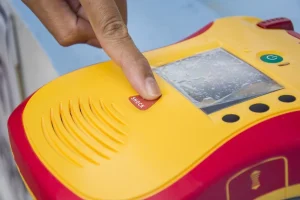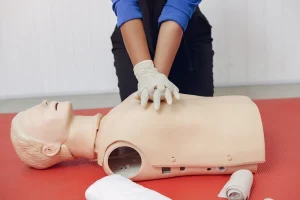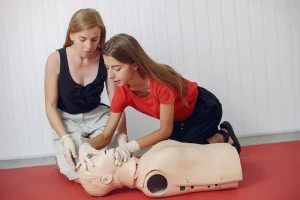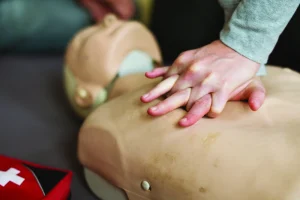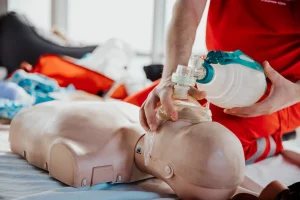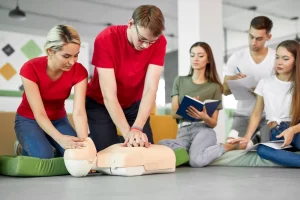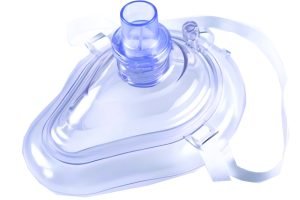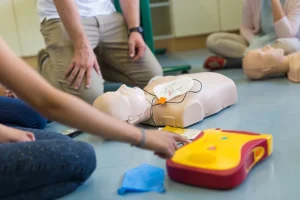Definition of a Scam
A scam is a fraudulent scheme or deceptive practice designed to defraud individuals or organizations. This typically involves tricking victims into believing they are dealing with a legitimate person or company to obtain their money, personal information, or valuable assets. Scams can take many forms, including false investment opportunities, fake charity organizations, online phishing scams, or identity theft. The perpetrators of scams often use manipulation, lies, and false promises to exploit their victims for financial gain. It is essential to be aware of the signs of a scam and take precautions to protect oneself from these deceitful tactics.
Overview of CPR Certification Programs
Different CPR certification programs are available, including those offered by the American Heart Association (AHA), online certifications from reputable organizations, and in-person training courses. The AHA offers courses such as Basic Life Support (BLS), Advanced Cardiovascular Life Support (ACLS), and Pediatric Advanced Life Support (PALS). Organizations like the National CPR Foundation and the American Red Cross offer online certifications.
In-person certifications typically involve hands-on training with a certified instructor, while online certifications utilize virtual simulations and video modules. Both types of certifications cover the same essential CPR techniques and skills. Still, in-person courses allow immediate feedback and instructor interaction, while online classes offer flexibility and convenience.
Participants must complete a certified training course and pass a skills assessment to obtain an official CPR certification card. The legitimacy of the certification can be verified by scanning the QR code on the card, which provides access to the participant’s training record and certification status.
Overall, various CPR certification options cater to different learning preferences and schedules, and all certifications provide the necessary skills for responding to cardiac emergencies.
Navigating the Validity of Online-Only CPR Certifications
In the digital age, the convenience of obtaining CPR certification online has become increasingly popular. Yet, whether online-only CPR certifications hold the same credibility as traditional, in-person certifications remains a topic of much discussion. It’s crucial to weigh the advantages and disadvantages of online CPR certifications to determine their suitability for your specific needs. This exploration delves into the legitimacy of online-only CPR certifications by examining critical aspects such as accreditation status, the necessity of hands-on training, and the degree of acceptance among employers.
Accreditation plays a pivotal role in the recognition of any CPR certification. Certifications accredited by reputable organizations such as the American Heart Association or the Red Cross are generally held in high regard. Online courses offered by such entities strive to meet the same rigorous standards applied to their in-person counterparts.
Another aspect to consider is the requirement for hands-on training. While online courses can provide the theoretical foundation of CPR techniques, the practical application of such skills is often best learned through direct, physical practice. Some online certification programs address this by offering hybrid options, which combine online coursework with in-person, hands-on sessions.
Employer acceptance is perhaps the most significant factor influencing the viability of online-only CPR certifications. Acceptance varies widely across industries and individual employers, with some requiring evidence of hands-on training as part of the certification process.
By understanding these critical factors, you can make an informed decision about the validity and reliability of online-only CPR certifications for your professional and personal life. Ultimately, the choice should align with your specific requirements, ensuring that the certification you obtain is recognized and respected in your intended field of application.
What About the Top National Certifications?
The American Heart Association, American Red Cross, and American Safety and Health Institute are the top national certifications in the United States that do not recognize 100% online training for CPR and BLS. These organizations require a hands-on component to receive official certification and cards.
The American Heart Association offers CPR and BLS certification courses, including in-person training and hands-on practice with an instructor. Certification can be obtained by taking a course through an authorized training center or scheduling a class with a certified instructor.
Similarly, the American Red Cross provides CPR and BLS certification courses that require in-person training and skills assessment. Courses are available through authorized training centers or the Red Cross website.
The American Safety and Health Institute also requires in-person training and hands-on practice for its CPR and BLS certification courses, which are offered through authorized training centers and instructors.
To obtain official certifications and cards from these organizations, individuals must complete the required training and pass a skills assessment. It is important to note that these national certifications for CPR and BLS do not recognize 100% online training.
Common Sense
Proper training and assessment for CPR, AED, First Aid, and BLS skills are crucial for responding effectively in emergencies. Online learning alone cannot fully achieve this. While online courses can provide a good foundation of knowledge, they cannot replace hands-on skills training and assessment. Online learning and physical skill training is necessary to ensure that individuals can confidently and correctly perform these life-saving techniques.
Mastering CPR, AED, First Aid, and BLS skills can have a significant life-saving impact. Practicing and drilling these skills until they become automatic is essential for responding quickly and effectively in high-pressure situations. This muscle memory can mean the difference between life and death in an emergency.
Therefore, it is essential to seek comprehensive training that includes online learning, physical skills practice, and assessment. By doing so, individuals can develop the confidence and proficiency to save lives in critical situations.
CPR is a Physical Skill
CPR (cardiopulmonary resuscitation) is a physical skill because it requires hands-on actions such as chest compressions and rescue breaths to help a person in cardiac arrest. Learning CPR involves understanding the proper positioning of hands, the correct depth of compressions, and the coordination of chest compressions with rescue breaths. These physical actions require proper technique and muscle memory to perform effectively.
Professional guidance from a certified instructor is crucial in learning CPR. Instructors provide knowledge of the proper techniques and offer hands-on practice and guidance to develop proficiency in performing CPR. Hands-on practice is essential to building muscle memory and confidence in executing the physical skills required.
Feeling for the proper positioning and depth of compressions is critical in CPR. Assessing and applying the necessary pressure and rhythm to the chest can significantly impact the outcome for the individual in need.
In conclusion, CPR is a physical skill that requires proper guidance from a professional instructor, hands-on practice to develop proficiency, and the ability to feel the appropriate positioning and depth of compressions. Mastering these physical skills can make a life-saving difference in emergencies.
Types of CPR Certifications
CPR certification programs are essential for individuals seeking life-saving skills applicable to cardiac arrest emergencies. These certifications are tailored to various needs, environments, and levels of responsibility, ensuring that everyone, from lay rescuers to healthcare professionals, can contribute effectively during critical moments.
The primary types of CPR certifications include Basic Life Support (BLS) for healthcare providers, Advanced Cardiovascular Life Support (ACLS) for medical professionals, and CPR/AED for the general public and non-medical personnel. Each certification focuses on specific techniques, such as using automated external defibrillators (AEDs) and performing CPR on infants, children, and adults, catering to the unique requirements of different settings and situations.
Pursuing a CPR certification enhances an individual’s ability to respond confidently to emergencies and enriches their professional qualifications, especially those in caregiving, education, and various public-serving roles. Understanding the distinctions between these certifications allows individuals to choose the most appropriate training for their needs, ultimately fostering a prepared and resilient community.
Online Training Courses
Several online CPR training courses are available, including those offered by the American Heart Association and the American Red Cross. Online courses provide instruction through videos, interactive modules, and quizzes, while blended programs include online learning and in-person, hands-on practice sessions. The hands-on component is essential for practicing and mastering CPR techniques and gaining confidence in CPR in real-life situations.
It is important to check with your employer to ensure their acceptance of online CPR training. Some workplaces may require certification from specific organizations or have particular requirements for CPR training. Many employers widely recognize and accept the American Heart Association and American Red Cross certifications.
Online CPR training offers flexibility and convenience for individuals with busy schedules or limited access to in-person training. However, ensuring that the chosen course meets any workplace or industry-specific requirements is crucial. With proper research and communication with employers, individuals can find the right online CPR training program to obtain the necessary certification.
Hands-On Session for American Heart Association’s HeartCode Certification
The American Heart Association’s HeartCode Hands-On Session is a critical step for those seeking to obtain a valid CPR certification recognized for two years. Emphasizing the necessity of practical skills and theoretical knowledge, this session ensures participants are fully equipped to respond to emergencies with confidence. The Occupational Safety and Health Administration (OSHA) mandates practical CPR training for specific industries, highlighting the importance of applying CPR techniques effectively in real-life scenarios.
The HeartCode course uniquely addresses this requirement by offering a blended learning approach. It combines online instruction, where individuals can absorb the theoretical elements of CPR at their pace, with a hands-on skills session. This in-person session, conducted by certified American Heart Association instructors, is designed to evaluate and reinforce the CPR skills acquired during the online portion of the course. By completing both components, participants earn a two-year CPR certification from the American Heart Association, affirming their capability to perform CPR in emergencies.
The American Heart Association’s HeartCode Hands-On Session is indispensable for acquiring a comprehensive and legitimate CPR certification. This balanced approach of online learning followed by practical application meets OSHA’s stringent requirements and sets a high standard for emergency preparedness and response.
Traditional Classroom Settings
In a traditional classroom setting, the physical layout typically consists of students seated in rows facing the front of the room. The teacher’s desk is generally positioned at the front, with a chalkboard or whiteboard behind them. This layout emphasizes the teacher’s central role in the classroom and promotes focused attention on the lesson.
In a traditional classroom setting, the teacher is the primary authority figure, responsible for delivering instruction, leading discussions, and managing classroom behavior. Students must listen attentively, raise their hands to speak, and follow the teacher’s directions.
In terms of student expectations, there is generally an emphasis on obedience, respect for authority, and adherence to classroom rules. The teacher typically sets the tone for the classroom environment and establishes expectations for student behavior and academic performance.
The traditional classroom setting is characterized by a teacher-centered approach, a structured physical layout, and clear roles and expectations for teachers and students.
Who Should Take CPR Certification?
CPR certification is a valuable skill for individuals in various professions and roles. It provides the knowledge and confidence to respond effectively in emergencies, potentially saving lives. From healthcare professionals to teachers, parents, coaches, and lifeguards, anyone in a position where they may need CPR should consider obtaining certification.
This training also benefits those in high-risk environments, such as construction workers or factory employees, and individuals who want to be prepared to assist in a medical emergency. Overall, CPR certification is a crucial skill for anyone who wants to be equipped to respond to cardiac emergencies and provide vital assistance when every second counts.
Healthcare Providers and the Importance of CPR Certification
Healthcare providers are at the forefront of patient care, making CPR certification crucial for maintaining the highest standards of care. This certification provides healthcare professionals with the essential knowledge and skills to respond effectively to life-threatening emergencies, such as cardiac arrests and respiratory failures. By staying updated with the latest CPR guidelines and practices, healthcare providers are better prepared to improve patient outcomes significantly. CPR certification is not just a requirement; it’s a fundamental aspect of healthcare that enhances patient care quality and embodies the healthcare profession’s commitment to preserving life.
The Role of CPR Certification for Personal Trainers and Fitness Professionals
For personal trainers and fitness professionals, CPR certification is more than a credential—it’s a testament to their commitment to client safety and health. Emergencies can occur without warning during physical activities, and being equipped with CPR skills is crucial. This certification ensures that fitness professionals are prepared to handle cardiac events and other health crises promptly and effectively, safeguarding their clients’ lives. Moreover, training in the latest CPR techniques promotes a safe training environment, bolstering the professional’s reputation and building client trust.
The Wide-Reaching Necessity of CPR Certification in Various Industries
CPR certification is vital across numerous sectors, especially in healthcare, education, child care, fitness, and construction. It’s also increasingly valued in less regulated environments like offices and retail spaces, enhancing safety. The renewal of CPR certifications, which may be annual for healthcare workers or biennial for others, depends on industry standards and organizational policies. Individuals need to ensure their certifications are recognized and accredited, with options for certification available through both in-person and online courses. These courses offer practical training for immediate application or the flexibility to learn at one’s pace respectively.
Empowering the General Public to Respond to Emergencies
Equipping oneself for emergencies involves more than just CPR knowledge; it requires comprehensive preparation. The general public is encouraged to assemble emergency kits containing vital supplies such as water, food, first-aid items, and necessary personal items. Developing a family communication plan is critical for maintaining contact in crises, including having up-to-date contact information and established meeting points. Additionally, staying informed about local risks and subscribing to emergency alerts ensures that individuals are aware of how to effectively protect themselves and their loved ones. Through preparedness, the community becomes a more vital, more resilient force against the unexpected challenges of emergencies.
Benefits of Having a CPR Certification Card
Having a CPR certification card offers numerous benefits. First, it allows individuals to meet workplace requirements, making them valuable assets to employers who prioritize safety and emergency preparedness. Second, being CPR-certified can save a life in an emergency. By possessing the knowledge and skills to administer CPR, certified individuals can assist in critical situations until professional help arrives. Furthermore, having a CPR certification card also provides credibility in the healthcare industry, showcasing a commitment to professionalism and readiness to respond to emergencies.
It is crucial to emphasize the consequences of fake CPR certification. Fake certification puts individuals at risk of being unprepared in an emergency and damages their credibility and integrity. Obtaining an official certification from reputable organizations such as the American Heart Association is imperative to avoid such repercussions. An AHA certification ensures that individuals have received proper training and are equipped to handle emergencies effectively and responsibly. It also provides peace of mind to employers and colleagues, knowing they can rely on certified individuals in need.
The Legitimate Certification Process
Ensuring that the training program meets industry standards and is accredited by recognized organizations is crucial to obtaining a legitimate CPR certification. Accreditation is essential as it ensures that the certification is valid and accepted by employers, healthcare organizations, and regulatory bodies.
The first step in obtaining a legitimate CPR certification is to enroll in a training program accredited by authoritative bodies such as the American Heart Association (AHA), the American Red Cross, or the Health & Safety Institute (HSI). These organizations offer in-person and online CPR certification courses that meet industry standards and are widely recognized.
To obtain certification, participants must complete the required coursework, which includes learning CPR techniques, understanding the steps to respond to emergencies, and passing a skills assessment. Online platforms such as the AHA’s eLearning portal and the American Red Cross offer accredited online CPR certifications, providing convenient and accessible options for individuals.
Upon completing the training and assessment, participants will receive a legitimate CPR certification recognized and accepted in various settings. It is crucial to verify the accreditation of the training programs and certification providers to ensure validity and acceptance within the industry.
How to Spot Fake Certifications
Fake certifications can be spotted by looking for certain buzzphrases on CPR certification cards, such as “AHA Certified,” “AHA Approved,” or “AHA Compliant.” Genuine certifications from the American Heart Association (AHA) do not use these phrases. Additionally, AHA certifications are typically issued in eCard format, so if a certification card is not in this format, it may be a red flag.
Another critical factor is whether the certification includes a hands-on skills portion. AHA standards require individuals to demonstrate their skills in person, so a certification without this component may be fraudulent.
If you suspect a certification is fake, it is crucial to report it to the American Heart Association. You can do so by calling 1-800-242-8721 or by emailing reportfraud@heart.org. Reporting fraudulent certifications is essential to maintaining the integrity of life-saving certifications and preventing individuals from falsely claiming to have the necessary skills.
Be cautious of buzzphrases, check for eCard format for AHA certifications, and verify that the certification includes a hands-on skills portion. If you encounter a potentially fake certification, report it to the AHA using the provided contact information.
Different Organizations that Offer CPR Certifications
Several reputable organizations offer CPR certifications, catering to various preferences for traditional in-person and online training methods. The American Heart Association (AHA) and Health & Safety Institute (HSI) are among the most widely recognized organizations providing comprehensive CPR certifications. These entities offer diverse training options, including in-person classes and blended learning courses that combine the convenience of online instruction with the rigor of hands-on practice.
The AHA is renowned for its rigorous standards. It recognizes online training as a legitimate method of instruction and offers accreditation for online classes that align with its criteria. Similarly, HSI provides various CPR certification options, embracing both digital and physical classroom settings to accommodate different learning styles and requirements.
The American Red Cross also plays a significant role in CPR training, offering certifications through in-person and online classes. Like its counterparts, the Red Cross ensures its online training programs meet industry standards for accreditation and compliance, reinforcing the credibility of its certifications.
ABC Health and Safety Training stands out by providing certifications from HSI and AHA, ensuring learners receive a high-quality education that meets recognized industry standards. When selecting an online CPR certification, it’s crucial to choose providers like ABC Health and Safety Training that adhere to the accreditation standards set by these esteemed organizations, guaranteeing compliance with industry guidelines for CPR training.
Organizations like the American Heart Association, Health & Safety Institute, and American Red Cross offer valid and recognized online CPR certification options, adhering strictly to industry standards for accreditation and compliance. Through providers like ABC Health and Safety Training, individuals have access to a wide range of CPR certification options, ensuring they receive training that is both effective and reputable.
Why take CPR training from ABC Health & Safety Training?
ABC Health & Safety Training offers several advantages when considering CPR training. First, it is accredited by the American Heart Association, a nationally recognized organization, ensuring its CPR certification is widely recognized. Its traditional classes provide convenience and the flexibility to study and gain hands-on knowledge, allowing busy individuals to fit training into their schedules. Additionally, the option to renew CPR certification online makes it easy to stay current with training requirements.
By taking CPR courses from ABC Health & Safety Training in Vacaville, individuals can improve patient outcomes and potentially save lives. Healthcare workers trained in CPR are better equipped to respond to emergencies and provide life-saving care. With ABC Health & Safety Training, individuals can gain the skills and confidence to respond effectively in critical situations, ultimately positively impacting patient outcomes.
ABC Health & Safety Training’s accreditation, nationally recognized certification, traditional classes, and focus on improving patient outcomes make them a top choice for CPR training in Vacaville, California.



